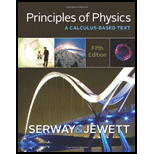
Concept explainers
(a)
The radius of the hemisphere.
(a)
Answer to Problem 69P
The radius of the hemisphere is
Explanation of Solution
Given info: The weight of the black cat is
The formula to calculate the total mass is,
Here,
Substitute
The formula to calculate the mass of the hemisphere is,
Here,
Substitute
Conclusion:
Therefore, the radius of the hemisphere is
(b)
The area of the curved surface.
(b)
Answer to Problem 69P
The area of the curved surface is
Explanation of Solution
Given info: The weight of the black cat is
The formula to calculate the area is,
Substitute
Conclusion:
Therefore, the area of the curved surface is
(c)
The power emitted by the cats.
(c)
Answer to Problem 69P
The power emitted by the cats is
Explanation of Solution
Given info: The weight of the black cat is
The formula to calculate the power emitted is,
Here,
Substitute
Conclusion:
Therefore, the power emitted by the cats is
(d)
The intensity of
(d)
Answer to Problem 69P
The intensity of radiation at the surface is
Explanation of Solution
Given info: The weight of the black cat is
The formula to calculate the intensity of radiation is,
Substitute
Conclusion:
Therefore, the intensity of radiation at the surface is
(e)
The amplitude of electric field in the
(e)
Answer to Problem 69P
The amplitude of electric field in the electromagnetic wave is
Explanation of Solution
Given info: The weight of the black cat is
The formula to calculate the amplitude of the electric field is,
Here,
Substitute
Thus, the amplitude of electric field in the electromagnetic wave is
Conclusion:
Therefore, the amplitude of electric field in the electromagnetic wave is
(f)
The amplitude of magnetic field in the electromagnetic wave.
(f)
Answer to Problem 69P
The amplitude of magnetic field in the electromagnetic wave is
Explanation of Solution
Given info: The weight of the black cat is
The formula to calculate the amplitude of the magnetic field is,
Substitute
Conclusion:
Therefore, the amplitude of magnetic field in the electromagnetic wave is
(g)
The total power radiated by the family of cat.
(g)
Answer to Problem 69P
The total power radiated by the family of cat is
Explanation of Solution
Given info: The weight of the black cat is
The formula to calculate the mass of the hemisphere is,
Here,
Substitute
The formula to calculate the power radiated by the kittens is,
Here,
Substitute
The formula to calculate the mass of the hemisphere is,
Here,
Substitute
The formula to calculate the power radiated by the cat is,
Here,
Substitute
The formula to calculate the total power radiated by the family of cat is,
Substitute
Conclusion:
Therefore, the total power radiated by the family of cat is
Want to see more full solutions like this?
Chapter 24 Solutions
Bundle: Principles of Physics: A Calculus-Based Text, 5th + WebAssign Printed Access Card for Serway/Jewett's Principles of Physics: A Calculus-Based Text, 5th Edition, Multi-Term
- ! Required information Assume that the magnifier is held close to the eye. Use the standard near point of 25.0 cm to find the angular magnification. An insect that is 4.10 mm long is placed 10.3 cm from a simple magnifier with a focal length of 13.0 cm. What is the angular magnification?arrow_forward2arrow_forward3arrow_forward
- Imagine you are out for a stroll on a sunny day when you encounter a lake. Unpolarized light from the sun is reflected off the lake into your eyes. However, you notice when you put on your vertically polarized sunglasses, the light reflected off the lake no longer reaches your eyes. What is the angle between the unpolarized light and the surface of the water, in degrees, measured from the horizontal? You may assume the index of refraction of air is nair=1 and the index of refraction of water is nwater=1.33 . Round your answer to three significant figures. Just enter the number, nothing else.arrow_forwardDeduce what overvoltage is like in reversible electrodes.arrow_forwardpls help on thesearrow_forward
- pls help on thesearrow_forward20. Two small conducting spheres are placed on top of insulating pads. The 3.7 × 10-10 C sphere is fixed whie the 3.0 × 107 C sphere, initially at rest, is free to move. The mass of each sphere is 0.09 kg. If the spheres are initially 0.10 m apart, how fast will the sphere be moving when they are 1.5 m apart?arrow_forwardpls help on allarrow_forward
 Principles of Physics: A Calculus-Based TextPhysicsISBN:9781133104261Author:Raymond A. Serway, John W. JewettPublisher:Cengage Learning
Principles of Physics: A Calculus-Based TextPhysicsISBN:9781133104261Author:Raymond A. Serway, John W. JewettPublisher:Cengage Learning Physics for Scientists and EngineersPhysicsISBN:9781337553278Author:Raymond A. Serway, John W. JewettPublisher:Cengage Learning
Physics for Scientists and EngineersPhysicsISBN:9781337553278Author:Raymond A. Serway, John W. JewettPublisher:Cengage Learning Physics for Scientists and Engineers with Modern ...PhysicsISBN:9781337553292Author:Raymond A. Serway, John W. JewettPublisher:Cengage Learning
Physics for Scientists and Engineers with Modern ...PhysicsISBN:9781337553292Author:Raymond A. Serway, John W. JewettPublisher:Cengage Learning Physics for Scientists and Engineers, Technology ...PhysicsISBN:9781305116399Author:Raymond A. Serway, John W. JewettPublisher:Cengage Learning
Physics for Scientists and Engineers, Technology ...PhysicsISBN:9781305116399Author:Raymond A. Serway, John W. JewettPublisher:Cengage Learning Classical Dynamics of Particles and SystemsPhysicsISBN:9780534408961Author:Stephen T. Thornton, Jerry B. MarionPublisher:Cengage Learning
Classical Dynamics of Particles and SystemsPhysicsISBN:9780534408961Author:Stephen T. Thornton, Jerry B. MarionPublisher:Cengage Learning Physics for Scientists and Engineers: Foundations...PhysicsISBN:9781133939146Author:Katz, Debora M.Publisher:Cengage Learning
Physics for Scientists and Engineers: Foundations...PhysicsISBN:9781133939146Author:Katz, Debora M.Publisher:Cengage Learning





